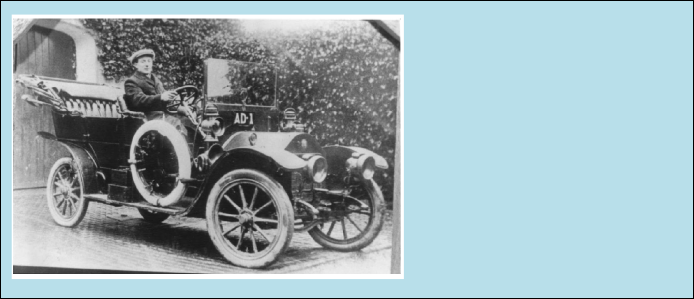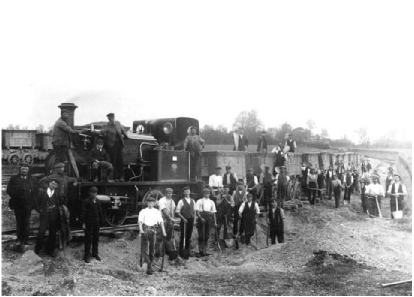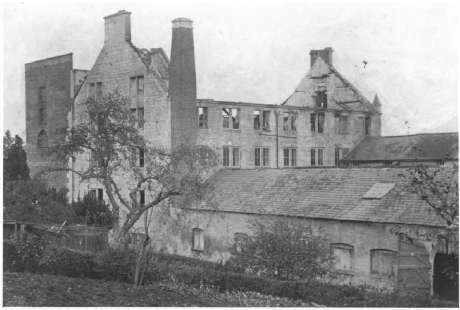

Many will remember Fred Ireland who wandered round the parish in a long coat, with a tall stick, telling his stories to anyone who had the time to listen.
In 1992, aged about 82, he wrote or dictated his ‘Memories of Eastington’ .
Photographs with captions courtesy of Stephen Mills.
2 Alkerton Terrace. FEB 1992
FRED IRELAND -
The first C. of E. Parson I knew was George Thomas Altimus Ward M.A. (music). A short, portly Irishman, when motoring wearing a flat-
The Rector’s hall was situated near the Millend side of the Coachouse yard, entered through a door in the stone wall from Millend Lane, used on Saturday nights for dancing sixpenny Hop. Also Lantern slides; Mr Armstrong worked the lantern.
The Rector’s Hall was also used for Sunday School classes and concerts but never on a Friday – the Rector considered all Fridays sacred as Good Friday – he therefore had a considerate Christian witness. For me, a C. of E. Sunday School scholar, the highlight of the year was the Sunday School tea party and annual prize-
Mr Ward owned (I understand) the first motor car in the county, AD I, grey coloured; headlights only working when moving.

Rev Ward’s car
In 1903, the Reverend George Thomas Altimus Ward (rector, musician, printer, mechanic, and enthusiastic pioneering motorist) arrived in the village.
This is his first car, a French-
This was the very first registration of any motor vehicle in the county of Gloucestershire.
The second motor vehicle I remember was a French Donaq (?) three wheeler owned by Fred Clutterbuck the village undertaker. I noticed a coffin strapped across the back, behind the driver.
The first taxi passenger I remember belonged to G. E. Law of Bath Rd. Garage probably a 3 or 4 seater, a somewhat vibrating vehicle for I had a ride at the front being friendly with his son Lionel.
The first motor cycle I remember belonged to Francis Clutterbuck; it was red and had to be pedalled before the engine took over. Later on, Jack Barham had a superb Harley Davidson with long “rib tickling” handlebars.
Harold Brinkworth the fishmonger owned a green Trojan motor van with no differential gear; the back wheels swivelled to negotiate bends in road.
The first football match I remember seeing was by the side of the Frocester road; I walked from Cress Green and crossed the Elm Hay field into the Bath Road, I was then about 4 years of age. I have reason to believe (from memory) that the new playing field was originally part of the football field of years ago for I remember taking a short cut down Snakey Lane instead of Puddlesworth Lane. The Eastington schoolboys also played there.
I remember a small horse-
Strong drink was also supplied – it was a bakery and public house.
Slightly on the right was a very high wooden building housing Percy Croom’s high brake on which I travelled to Framilode to the Darrell Arms Hotel. The seats were very high up -
During the First World War (or just after) I remember seeing the German Prisoners of War marching from Frocester to Frampton, each wearing a field grey flat topped service cap. A railway line ran from Frocester to Frampton to transport gravel to Frocester railway. There was a level crossing over the (now) A38 and it ran over the fields near the road opposite Osborn House.


The mineral railway
To Frampton-
The two-
In 1918, a detachment of the Royal Defence Corp was stationed near the Frampton gravel pits along with several hundred POWs.
Seven different small locomotives were used on the branch and the various lines around the pits. This shows an 0-
I well remember the last World War peace celebrations. Tea and concerts in the Rector’s Hall and burning the effigy of Little Willie, the German crown prince, in front of the King’s Head Hotel. I saw the silvery tin cross on his tunic. Later a tea and more “male” refreshments at the school. Servicemen were allowed to take a friend. Octavius Hulbert sang comic songs and I saw Walter Lewis playing the flute. There was a fancy dress exhibition down the Flat cricket field. Walter Lewis dressed as Robinson Crusoe and his brother dressed as a woman. Young Sidney Lewis was dressed in Khaki – his father was killed on active service. The band there played on a farm wagon; Octavius Hulbert playing a trombone.
Captain Turner of the Grange, Eastington, acted very kindly giving sports with prizes down the flat cricket field -
I remember seeing the first low flying aircraft – I ran to see where it landed without wearing a jacket. Mrs. Sadler from the baker’s shop ran also with a sweeping brush in her hand. It came down near the viaduct near Hooper’s Mill; the landing wheels must have skimmed the railway lines on the embankment before it came down.

Beards Mill viaduct – Fred refers above to Hooper’s mill. This is the one now more commonly called Beards Mill in Leonard Stanley. It was one of five mills once operated by the Hoopers – this one was largely demolished around 1910-
The photograph was taken in 1884 during the construction of the viaduct by the Midland Railway. It replaced an earlier 40 year old wooden version designed by Brunel. The new structure used three quarters of a million bricks, weighing about 2000 tons, sitting on top of the same quantity of concrete.
The lattice iron gantry was replaced in the 1970s but, remarkably, the rest remains largely unchanged.
In the late 1920s I saw many of the Kings Cup aircraft race low over the village.
I remember in the 1920s Millend Mill on fire. Seeing both buildings burnt right out owing to the kiln becoming overheated. One school holiday I ‘picked’ (cleaned out the holes of the kiln tiles) with a wire nail driven through a piece of wood 1 x 1 x 3 inches long for a penny each. 20 for 20 pence. Many of these tiles are now used to fill up the mill windows. (some were in place until the 2013 renovation)
Millend Mill manufactured cattle food made from low grade wheat, crushed fruit, skins from the local cider press and mangolds pressed into slabs about 1 inch thick x 15 x 12 in. Later cattle cubes were made. The mill was unique, driven by turbines, the surplus water being directed sideways; no fresh cutting therefore required as Churchend Mill.


Millend Mill fire – this shows the mill after the devastating fire in the early 1920s. It was effectively gutted. A new roof and wooden interior was eventually installed and this remained in place (although very rotten!) until the present redevelopment began a few years ago. At the time of the fire, the mill was in use as a maltings operated by the Sleeman family.
The fire started in the kiln at the front, used to warm beds of barley as part of the malting process.
Meadow mills made a fine quality fibre-
A powerful press was supplied by “Taylor and Challover” which would punch about 100 6mm holes at one operation. It could be heard ¼ mile away. Also a powerful guillotine supplied by H. O. Strong of Bristol. The 2 mill turbines could be heard day and night and could be geared to the engine. A powerful Robey steam engine supplied the power and when running 2 shifts 6 a.m. & 6 p.m., if no failure, would run Mon. 6 a.m. to Sat. 12.15 pm.
Bonds Mill, the last of the 5 mills running in the village closed about the end of 1935-

Meadow Mill
– this is the mill in the early years of the last century, when it was busy producing fibreboard. It was originally built around 1818.
Like Millend, it was one of (Lord of the Manor) Henry Hicks’ woollen mills.
Here, the field in front is flooded, as it was last winter (2013). The tall chimney stack was for a Boulton & Watt beam engine that (along with water wheels) once provided power for the mill.
As Fred mentions, it later used a newer steam engine and water turbines, quite a rarity in the region. During the Second World War, the Ruberoid company were in residence.
I remember when living at Cress Green seeing Selsley Church on fire, the roof engulfed in flames.
I well remember the giant Golden Chain tree in front of the King’s Head Hotel reaching almost to the roof. The first tenant of the hotel was name of Vaughan, having a son and a daughter – the girl was the first I remember using stills (stilts?).
Mr Armstrong was the first I remember who ran a motor coach Saturdays to the Empire at Stroud for entertainment.
May Day school celebrations used to be one of the choice days of the year, Maypole dancing. Walter Lewis’ box-
One year the treat from the proceeds from the money collected was a trip on the local canal from Eastington Wharf to the junction of the Gloucester to Sharpness Canal and tea and games before returning. Two vessels, a motor boat towing a spotlessly clean barge, and much enjoyed by all.
One of the village sporting highlights was when Eastington Footballers were the champions of the Northern Senior League. They beat High Beech One-

Fred Ireland
with illustrations and comment by Steve Mills
Published in two parts in
ECN 141 Oct/Nov 2013
and ECN 142 Dec 2013/Jan 2014
Memories of Fred Ireland
